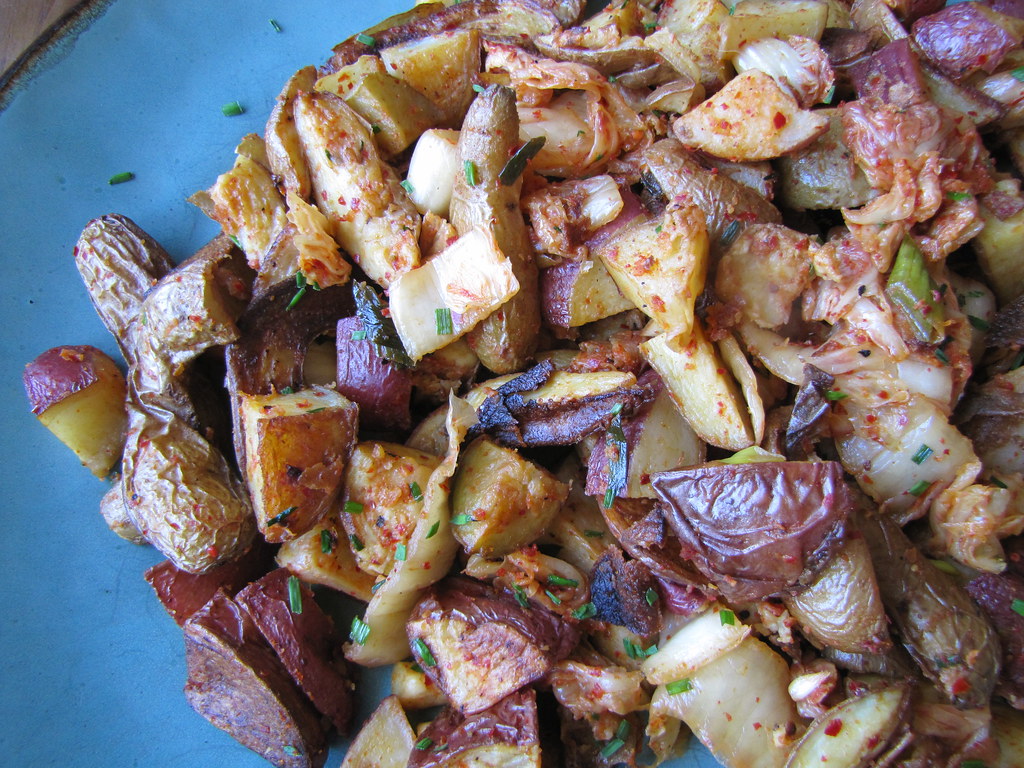
Hear me out: making kimchee at home is really easy! And the payoffs are practical in the kitchen, too. Here’s a look at my first attempt at making a true, Korean friend-approved batch of kimchee, and one way to put it to delicious use: as a seasoning for everyday, ever-versatile roasted potatoes.
I’d savored kimchee in many preparations here on this blog, and straight from the jar, too, but had always thought I couldn’t match the pitch-perfect crunch and tanginess of my favorite artisanal brands, Mama O’s and Mother-in-Law’s. Actually, kimchee ferments the longer it sits, even in the fridge, so each time I dug into those jars it was different every time. It’s a living, changing food. So even if it doesn’t taste quite right the first time, I could always let it ferment more, I figured.
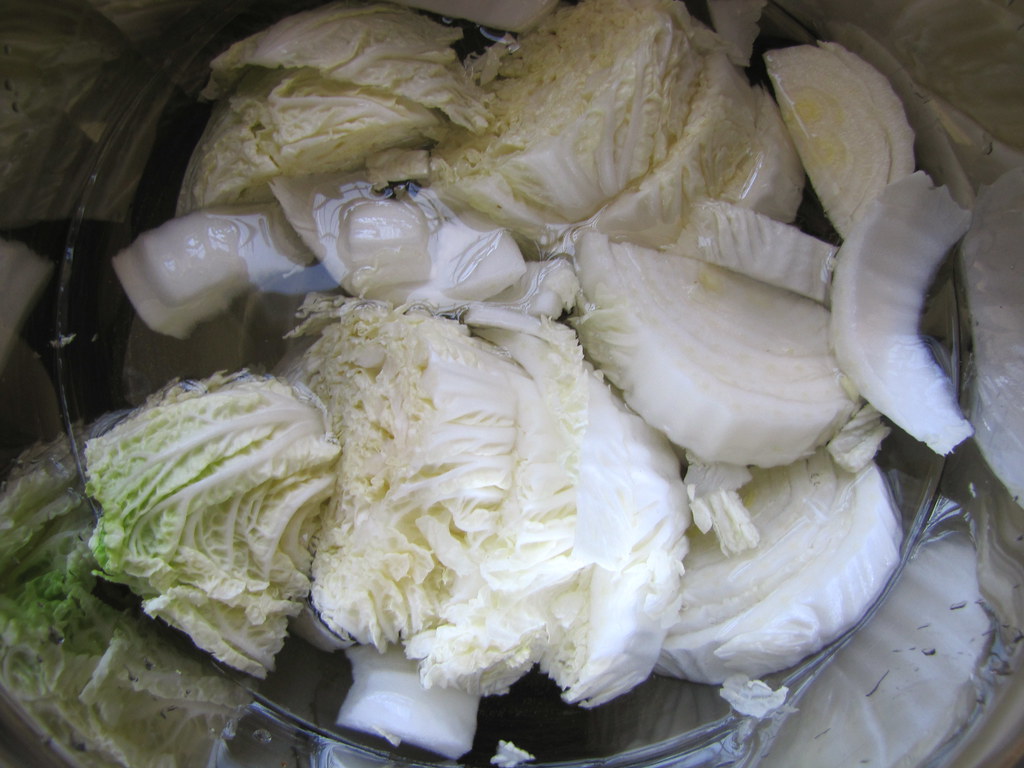 Napa cabbage is first soaked in salted water
Napa cabbage is first soaked in salted water
The lacto-fermentation is one part of the equation when it comes to its overall taste. But the traditional seasonings in kimchee are substantial. These are mainly garlic, ginger, Korean red chili flakes and something fishy, like oysters or fish sauce. I had a good half of a head of Napa cabbage leftover (from making dumplings) and scallions, too, so with all these ingredients (except the oysters) I set forth on making a classic-flavored kimchee.
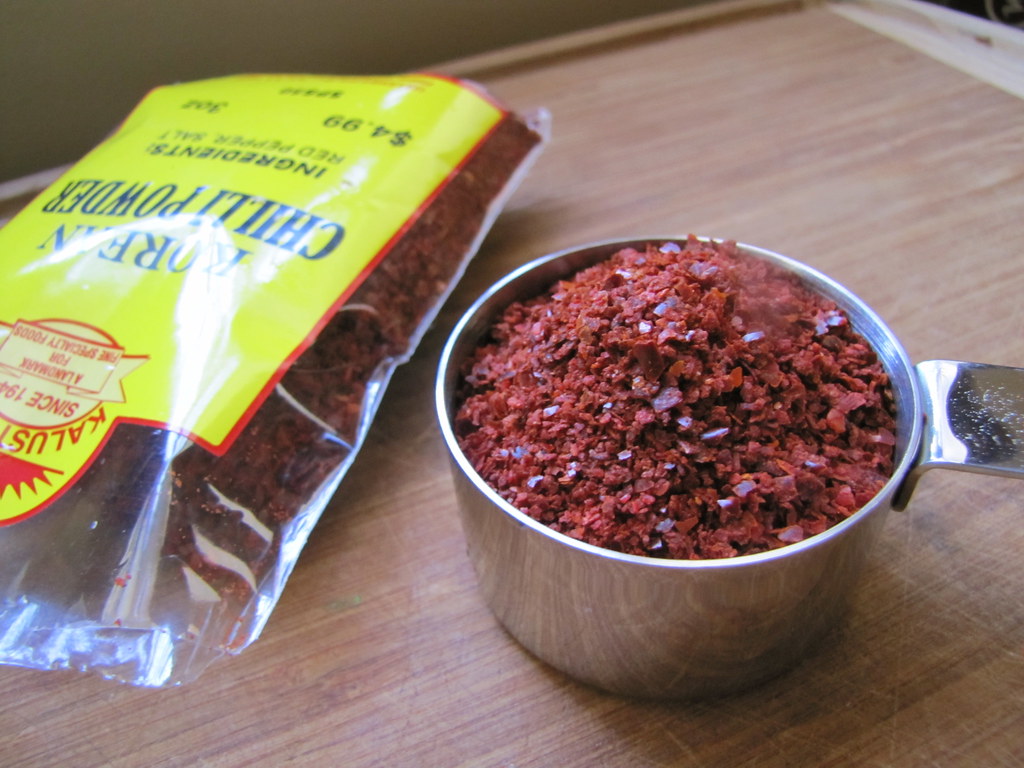 big, grainy Korean chili flakes
big, grainy Korean chili flakes
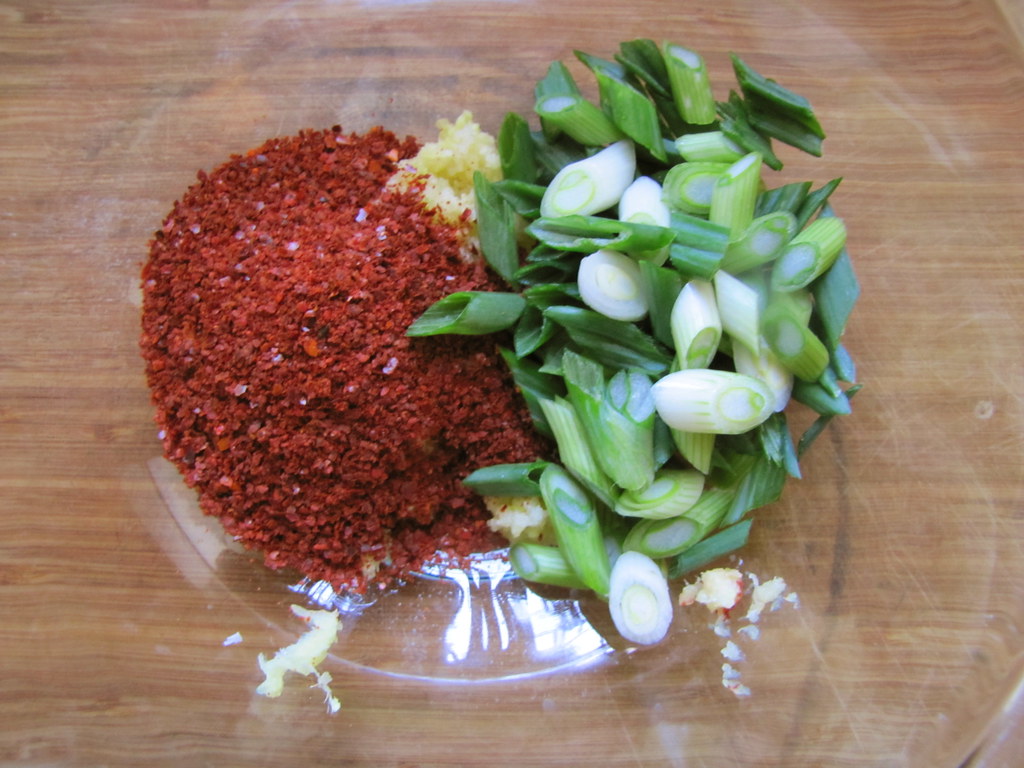 making a paste of chili, grated garlic, ginger, scallions and fish sauce
making a paste of chili, grated garlic, ginger, scallions and fish sauce
It was easier done than said in recipes. I was amazed; cold-pack pickling (which gives you classic jarred pickles and jam) requires grappling with boiling water and hot jars; sauerkraut and other lacto-fermented pickling usually involves pressing down vegetables with weights and draining fluids from them every day. When making kimchee, you simply stuff the seasoned vegetables inside a clean jar, leave it on the counter, and wait five or six days.
It’s fun, too. After a couple days, I noticed the jar had begun to dribble reddish juices from its lid. Not too much, and a paper towel was placed under the jar to soak up any more drops for the next few days. But it was beginning to bubble and fizz inside, the sugars converting to lactic acid. The aroma of grated garlic and ginger began to ooze from the sealed glass jar, waiting to escape. And then, after five days, I popped off the top. It was like opening a bottle of soda, shaken up. Red, garlicky juices spurted with the first twist, then I opened it slowly over the sink.
 kimchee protrudes from the popped-out jar
kimchee protrudes from the popped-out jar
It probably tastes different now, a few days afterward, but it tasted right then just about “perfect” to me. Pungent and pickled, it was the kimchee that I’d hoped for. No offense, master kimchee makers!
I’d picked up an assortment of potatoes recently from the Greenmarket, and decided to roast them for this simple dish. The tangy, spicy and wilted-but-crunchy cabbage makes a cool contrast with warm roasted potatoes. I topped this platter of them tossed together with fried eggs, to let the yolks give them some more juice. Some freshly chopped chives or scallions adds more color and freshness to the finished dish, too. It was a one-dish breakfast, and could be a hearty and flavorful side with just about anything.
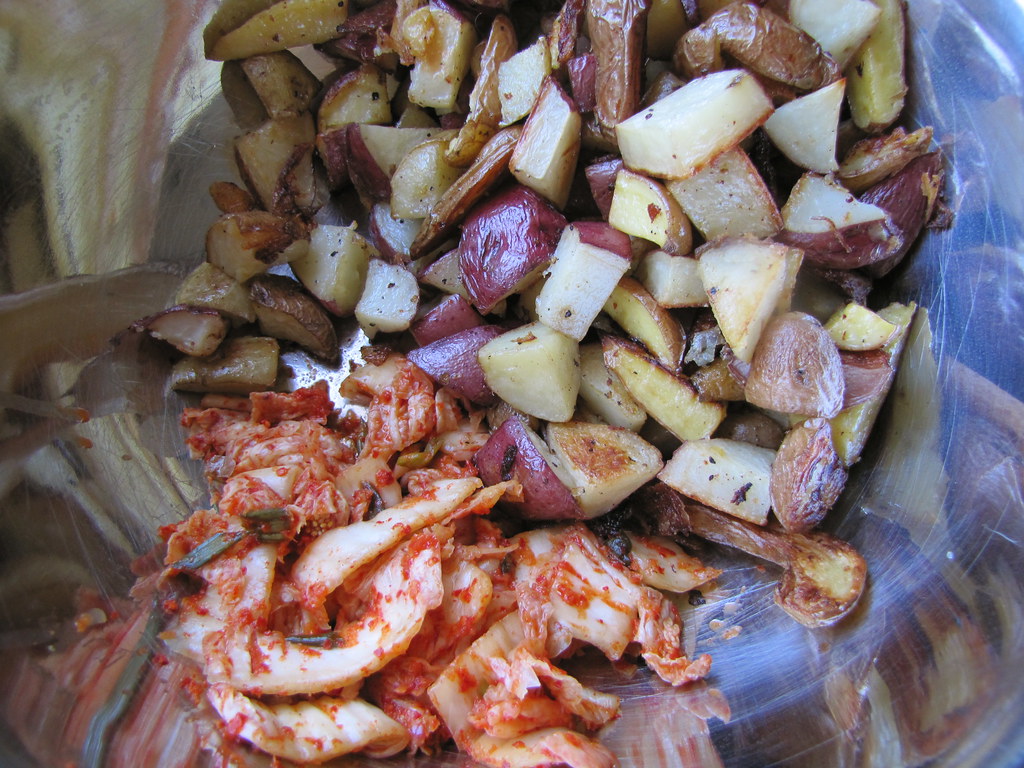 assorted potatoes are roasted with olive oil, salt and pepper and tossed with kimchee out of the oven
assorted potatoes are roasted with olive oil, salt and pepper and tossed with kimchee out of the oven
Now that the first batch of kimchee’s said and done, I’m curious about trying out different seasonings with my next. Or perhaps different vegetables. We’ll see! Since the recipe for roasted potatoes with kimchee is basically that, tossed together, I thought I’d simply provide my kimchee recipe, which makes a small amount perfect for the beginner’s batch.
Kimchee Roasted Potatoes
(makes 4-6 side-dish servings)
1 lb potatoes (such as red, Yukon gold, fingerlings, or another waxy, less-starchy variety, preferably)
2-3 tablespoons olive oil
sprinkle of salt and pepper
1/2 cup classic napa cabbage kimchee (recipe below)
1-2 fresh scallions, chopped
Preheat oven to 375 degrees. Rinse and scrub potatoes, and chop into even-sized wedges or cubes about 1/2″-1″ large. Spread in an even layer on cookie sheets and roast about 15 minutes; remove to toss with tongs or a spatula and roast another 10-15 minutes or until tender. Remove from oven, scraping from pan to keep them from sticking, and let cool for 5-10 minutes. Coarsely chop the kimchee and toss both together in a large bowl. Serve with the chopped scallions for garnish.
Classic Napa Cabbage Kimchee
(makes 1 16-oz. mason jar)
half a small head Napa cabbage (a little less than 1 lb), cored and chopped
8 cups water
1/4 cup Kosher salt
4-5 cloves garlic, grated
1-inch knob ginger, peeled and grated
1/4 cup Korean chili flakes (can be found in Asian or spice markets)
2 teaspoons fish sauce
3 scallions, both green and white parts, sliced on a bias
Combine the salt and water in a large bowl and stir until dissolved. Soak the cabbage leaves and cover surface with plastic wrap to keep them submerged. Let sit at room temperature for 2 hours.
Combine the rest of the ingredients in another large bowl. Strain the cabbage and add to the mixture, tossing to combine evenly. Pack tightly into a sterilized 16 oz. mason jar and seal shut. Leave at room temperature for 5 days or up to a week. After opened, refrigerate.
Cost Calculator
(for 1 jar of kimchee)
1/2 small head Napa cabbage (at $2/lb): $1.75
1/4 cup Kosher salt: $0.50
5 cloves garlic: $0.30
1 inch piece ginger: $0.25
1/4 cup Korean chili flakes (at $4.99/3 oz.): $2.25
2 tsp fish sauce: $0.25
3 scallions (at $2/bunch): $1.00
Total: $6.30
Health Factor![]()
![]()
![]()
![]()
Four brownie points: As a snack or condiment, the spicy, crunchy kimchee really satisfies and is beneficial beyond its intense flavor. Although high in sodium (which makes it so great to flavor other foods with) these lacto-fermented pickles have probiotic cultures to help you digest the rest of your meal. In addition, Napa cabbage itself carries a wealth of nutrients, including Vitamin C, like other cabbages. It’s a potent combination.
Green Factor![]()
![]()
![]()
![]()
![]()
Five maple leaves: Although winter cabbage is still in healthy stock locally, I traveled to Chinatown to get many of the ingredients for dumplings (and, in its aftermath, these ones, too). So the Napa cabbage was found there, and I made sure to wash the leaves should any pesticides have touched them. It’s really best to go organic or by a trusted, chemical-free farm for anything you’re serving fresh, or fermented. I have a new head of green cabbage from the farmers’ market I intend to try using for my next version.
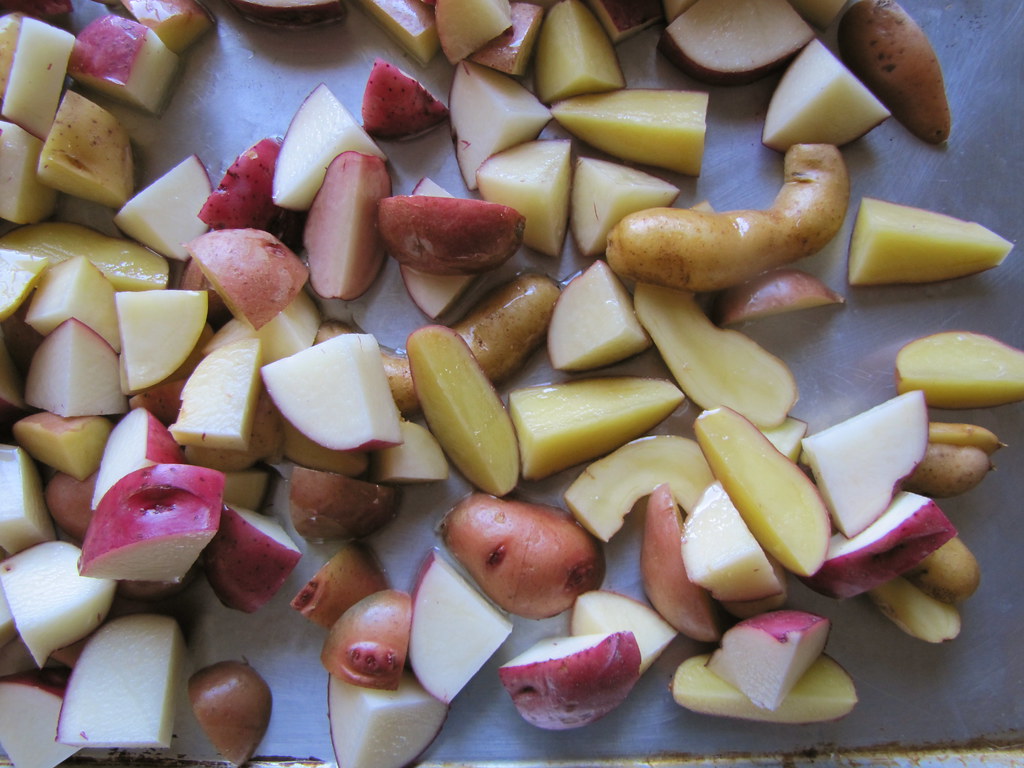
7 Responses
fashion
looking beautiful and interesting work.
Jean
Great job! I am Korean and I sometimes make my own kimchee! Next time, add little bit of sugar and it will make a difference! When I make mine, I put tons of chili flakes to make it spicy! Have you made soup with kimchee when it is fully fermented?
jimmy pots and pans
great dish, it’s on our menu now!
saç kaynak
i like mostly grill potato , but it look so delicious to…
Jannie
Nice! I learned how to make kim-chi from my mom.. Instead of fish sauce, you should tried blended up raw shrimp or squid. Also, Daikon is shredded and added to bring out the freshness taste!
imoveis na cidade de niteroi
retail showroom nearby? you make purchases only…
in two situations – when you need a specific product or services, and/or when you are impressed with it. will you be impressed with a product or service if no one is there to help you and guide why you should…
globalsubwaycom
I love to have french fries which are made of fresh potatoes in Subway restaurants. I have won free coupons for getting cookies, fountain drinks by taking the subway customer feedback survey https://surveysaga.com//www-global-subway-listens-com/